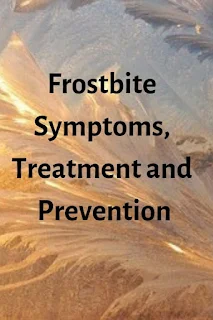The dangers of frostbite are very real, and getting frostbite is easier than you think. Frostbite can range from just painful to life-threatening and losing parts of your body. Learn how to prevent frostbite, how to recognize and treat it.
Frostbite can range from slightly painful to life-threatening and losing parts of your body. Every year people get minor frostbite just going for a walk or shoveling snow to severe frostbite to where they could lose a hand or foot.
What is Frostbite
Frostbite is the freezing of tissue; your skin actually freezes. When skin freezes, ice crystals form in the cells causing physical damage and a permanent change in the chemistry of the cell.
Frostbite occurs 90% of the time in the hands, feet, nose, and ears. Frostbite is classified by the degree of tissue injury, just like burns. The different stages of frostbite are:
First-degree frostbite, or frostnip, is when only the surface of the skin freezes. It starts out with the area getting red. For example, your hands will start to turn bright red, this along with the prickly feeling, numbness or pain.
Your hands or feet could be swollen along with this redness. They will start to become painful when frostbite is starting. There won’t be any permanent damage, but the area can be sensitive to cold from then on.
I can tell you from experience when you are close to getting frostbite on your hands and you go into a warm house, it can be quite painful when they start to warm up.
The deeper tissues are not damaged and should heal within 3 to 4 weeks. The area could be permanently sensitive to cold. Depending on the size of the area with frostbite, you should have this checked by a doctor.
Third-degree frostbite appears as white, white blotches or blue color. The underlying tissue is also damaged and will feel cold and hard. After several weeks blisters will form with blood in them. This is a very serious condition, and there is a chance the person also has hypothermia and needs immediate medical attention.
Fourth-degree frostbite is when the muscles, tendons and deeper tissues freeze and requires immediate medical attention. This can cause the loss of fingers, toes, and feet, and can be life-threatening.
Hypothermia is life-threatening and occurs when the body temperature drops below 90 F (32 C) with uncontrollable shivering, slow speech, memory lapses, frequent stumbling, drowsiness and exhaustion and requires immediate medical attention.
How Your Body Loses Heat
Your body can lose heat a number of ways. Evaporation happens when your skin gets wet either from weather or sweating. As you start to dry, your body will cool. Conductive cooling is when you touch something cold like metal; this draws your body heat away.
Radiation cooling occurs when your body heat escapes, from being improperly dressed. And wind chill is a big factor in getting frostbite.
Wind Chill and Frostbite
It could be 5 F above zero (-15 C), but if the wind is blowing at 20 mph (32 km/h), the wind chill temperature is –15 F (-26 C). The wind chill temperature is the temperature on your exposed skin. With a wind chill of –19 F (-28 C) or lower, your exposed skin will get frostbite in 30 minutes.
A wind chill of –32 F (-35 C) can cause frostbite within 10 minutes to exposed skin. The wind chill is even more dangerous on cloudy days, and especially at night.
A wind chill of –32 F (-35 C) can cause frostbite within 10 minutes to exposed skin. The wind chill is even more dangerous on cloudy days, and especially at night.
How to Treat Frostbite
There are a number of things you can do yourself for frostbite. Get inside if possible. If your hands are turning bright red, it could be the start of frostbite. If you can’t go inside, at least put your hands under your armpits.
Do not rub the cold or frostbite area; this can cause further damage to the tissues. Take off all wet clothes right away and put on dry warm clothes. You can warm the frostbitten area with warm but not hot water. If your hands are numb, have someone else test the temperature of the water or you could burn your hands.
Put a towel in the dryer and then wrap your feet or hands in that towel.
Warm up the entire person, not just the frostbite areas. Put a blanket in the dryer and then wrap yourself or the person with frostbite in it.
Warm up by drinking warm soups, broths or herbal teas. Do not drink alcohol or anything with caffeine in it.
Since the area that has frostbite can be numb, be careful when putting hands near a fire; you could get burned, not feeling the heat's intensity.
Do not warm up or thaw the frostbitten area if you are going to get it cold again. Get to a permanent shelter, home or medical facility before warming the area up.
It is important to dress properly to avoid frostbite. Dress properly in layers, with the correct materials and cover all exposed skin.
Keep your gloves on. At –25 F (-32 C), I made the mistake and took my gloves off trying to start the car. The instant my fingers touched the keys it felt like I had touched a lit match. I had just gotten frostbite.
You can also get frostbite by touching something extremely cold.
Try to stay out of the wind.
Stay dry; if you get wet, try and change into dry clothes as soon as possible.
Drink a lot of water to stay hydrated, especially if you are at high altitudes. If you are planning a trip to higher elevations, acclimate yourself first.
Avoid alcohol. Alcohol is dehydrating and also constricts the blood vessels, causing less blood to flow to your extremities. Being drunk in cold weather is dangerous. Every winter there are stories of someone being found dead from hypothermia while drunk, even outside their own home. When drunk, you will not realize how cold you are.
And don't forget about your dog since dogs can also get frostbite.
Learning the proper ways to prevent frostbite is of course important. And if you or a friend do get frostbite, it is equally important to know the symptoms and proper treatment.
About the Author
Sam Montana is a certified Food Over Medicine instructor from the Wellness Forum Health Center and certified in optimal nutrition from the Harvard T.H. Chan School of Public Health.
© 2009-2019 Sam Montana
Do not rub the cold or frostbite area; this can cause further damage to the tissues. Take off all wet clothes right away and put on dry warm clothes. You can warm the frostbitten area with warm but not hot water. If your hands are numb, have someone else test the temperature of the water or you could burn your hands.
Put a towel in the dryer and then wrap your feet or hands in that towel.
Warm up the entire person, not just the frostbite areas. Put a blanket in the dryer and then wrap yourself or the person with frostbite in it.
Warm up by drinking warm soups, broths or herbal teas. Do not drink alcohol or anything with caffeine in it.
Since the area that has frostbite can be numb, be careful when putting hands near a fire; you could get burned, not feeling the heat's intensity.
Do not warm up or thaw the frostbitten area if you are going to get it cold again. Get to a permanent shelter, home or medical facility before warming the area up.
How to Avoid Getting Frostbite
It is important to dress properly to avoid frostbite. Dress properly in layers, with the correct materials and cover all exposed skin.
Keep your gloves on. At –25 F (-32 C), I made the mistake and took my gloves off trying to start the car. The instant my fingers touched the keys it felt like I had touched a lit match. I had just gotten frostbite.
You can also get frostbite by touching something extremely cold.
Try to stay out of the wind.
Stay dry; if you get wet, try and change into dry clothes as soon as possible.
Drink a lot of water to stay hydrated, especially if you are at high altitudes. If you are planning a trip to higher elevations, acclimate yourself first.
Avoid alcohol. Alcohol is dehydrating and also constricts the blood vessels, causing less blood to flow to your extremities. Being drunk in cold weather is dangerous. Every winter there are stories of someone being found dead from hypothermia while drunk, even outside their own home. When drunk, you will not realize how cold you are.
And don't forget about your dog since dogs can also get frostbite.
Learning the proper ways to prevent frostbite is of course important. And if you or a friend do get frostbite, it is equally important to know the symptoms and proper treatment.
About the Author
Sam Montana is a certified Food Over Medicine instructor from the Wellness Forum Health Center and certified in optimal nutrition from the Harvard T.H. Chan School of Public Health.
© 2009-2019 Sam Montana

